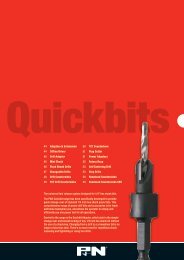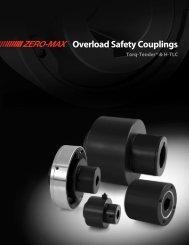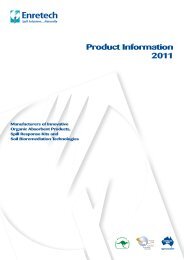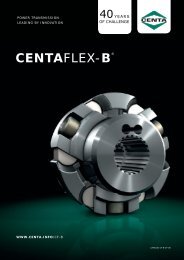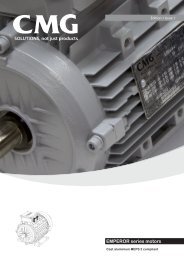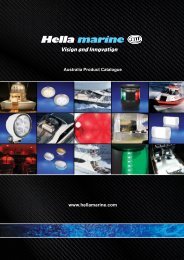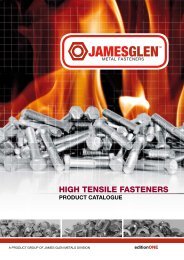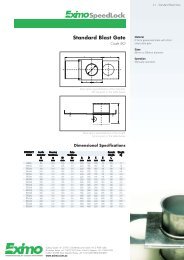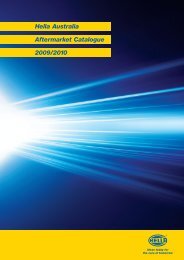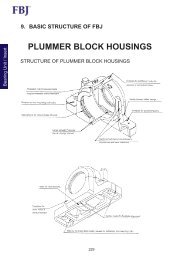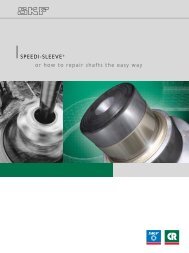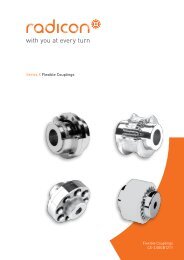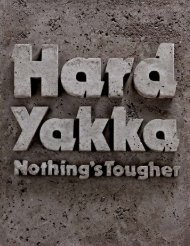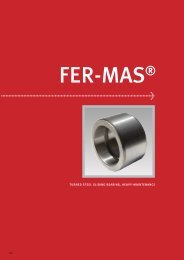Renold Couplings Cat 7th-4 - Industrial and Bearing Supplies
Renold Couplings Cat 7th-4 - Industrial and Bearing Supplies
Renold Couplings Cat 7th-4 - Industrial and Bearing Supplies
Create successful ePaper yourself
Turn your PDF publications into a flip-book with our unique Google optimized e-Paper software.
1.1 Diesel Engine Drives<br />
The RB Coupling is selected on the “nominal torque” TKN without<br />
service factors for Diesel Drive applications.<br />
The full torque capacity of the coupling for transient vibration whilst<br />
passing through major criticals on run up is published as the<br />
maximum torque.<br />
(TKmax = 3 x TKN ).<br />
There is an additional torque capacity built into the coupling for<br />
short circuit <strong>and</strong> shock torques, which is<br />
3 x Tkmax .<br />
The published “Vibratory torque Tkw ”, is a fatigue function<br />
according to DIN740 <strong>and</strong> not significant in diesel engine drives, the<br />
vibratory torque values shown in the Technical Data are at the<br />
frequency of 10Hz. The measure used for acceptability of the<br />
coupling under vibratory torque is heat dissipation of the rubber<br />
elements. The maximum allowable heat dissipation shown in the<br />
technical data is at a 30°C ambient temperature.<br />
1.2 <strong>Industrial</strong> Drives<br />
For industrial Electrical Motor Applications refer to the “Selection<br />
Procedures” <strong>and</strong> base the selection on Tkmax with the appropriate<br />
service factors.<br />
The service factors used in the “Selection Procedures” are based upon<br />
40 years experience of drives <strong>and</strong> their shock frequency/amplitude.<br />
The stated TKmax quoted should not be exceeded by design,<br />
without reference to <strong>Renold</strong> Hi-Tec <strong>Couplings</strong>.<br />
Care needs to be taken in the design of couplings with shaft brakes<br />
to ensure the coupling torques are not increased by severe<br />
deceleration.<br />
2.0 Stiffness Properties<br />
The <strong>Renold</strong> Hi-Tec Coupling remains fully flexible under all torque<br />
conditions. The RB series is a non-bonded type operating with the<br />
Rubber-in-Compression principle.<br />
2.1 Axial Stiffness<br />
When subject to misalignment forces in the axial direction, the<br />
coupling will have an axial resistance which gradually reduces<br />
due to the effect of vibratory torques.<br />
RB Technical Data<br />
For more information telephone us on +44 (0) 29 20792737 or fax +44 (0) 29 20791360 E-Mail: cardiff.sales@renold.com<br />
69<br />
Given sufficient axial force as shown in the catalogue, the<br />
coupling will slip to its new position immediately.<br />
2.2 Radial Stiffness<br />
The radial stiffness of the coupling is torque dependent, <strong>and</strong> is as<br />
shown in the Technical Data.<br />
2.3 Torsional Stiffness<br />
The torsional stiffness of the coupling is dependent upon applied<br />
torque (see Technical Data) <strong>and</strong> temperature.<br />
2.4 Prediction of the system torsional<br />
vibration characteristics.<br />
An adequate prediction of the system torsional vibration<br />
characteristics can be made by the following method.<br />
2.4.1 Use the torsional stiffness as published in the<br />
catalogue which is based upon data measured at a<br />
30°C ambient temperature (CT30). 2.4.2 Repeat the calculation made as 2.4.1 but using the<br />
maximum temperature correction factor St100 <strong>and</strong> M100 for the rubber selected for both torsional stiffness <strong>and</strong><br />
dynamic magnifier from the table on page 73.<br />
CT100 = CT30 x St<br />
2.4.3 Review the calculations 2.4.1 <strong>and</strong> 2.4.2 <strong>and</strong> if the speed<br />
range is clear of criticals which do not exceed the<br />
allowable heat dissipation value as published in the<br />
catalogue, the coupling is then considered suitable for<br />
the application with respect to the torsional vibration<br />
characteristics. If there is a critical in the speed range<br />
the actual temperature of the coupling will need to be<br />
calculated at this speed.



